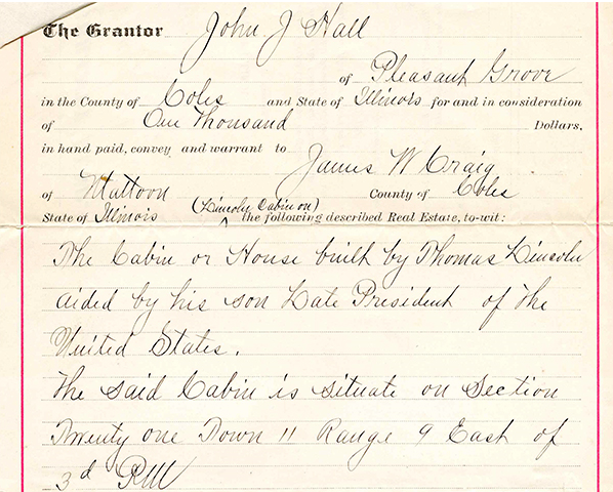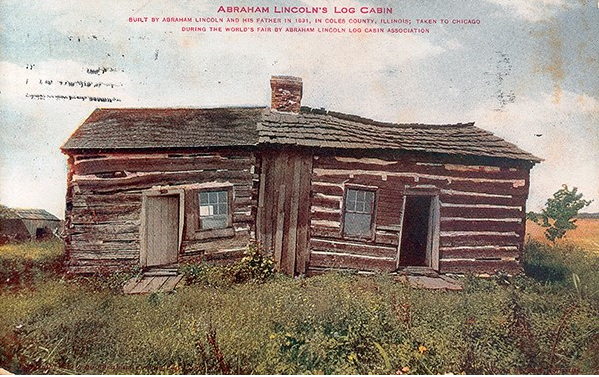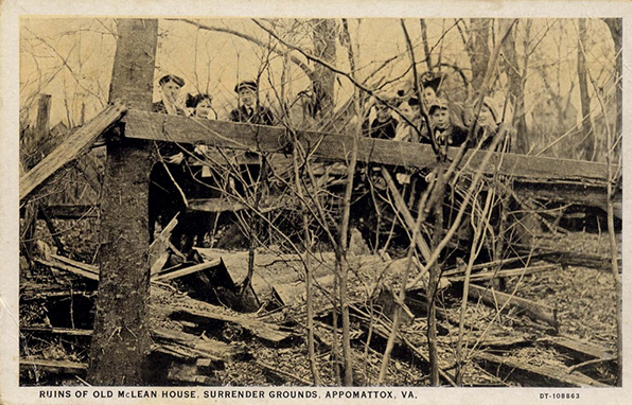By Michelle Miller
In 1831, Thomas Lincoln purchased a plot of land in Coles County, near a place that was then known as Goosenest Prairie, and built what would be his family’s final home. Though some claimed later that his son Abraham helped to build the cabin at Goosenest Prairie, it seems that the future president had already struck out on his own, making his home in New Salem. However, he did visit, and the house in Coles County held many other members of the family Thomas had built with his second wife, Sarah Bush Johnston. Thomas died in 1851 and Sarah died in 1869, leaving the property to her children from her previous marriage.
By 1892, the property had changed hands several times. John Hall, Sarah Lincoln’s grandson, had inherited the cabin and then sold it to James W. Craig of Mattoon in 1891. Then a group from Chicago calling themselves the Abraham Lincoln Log Cabin Association had purchased it from Craig. Finally, after holding it for a short period, the Log Cabin Association sold it to the Appomattox Land and Improvements Company, headed by Myron E. Dunlap of Niagara Falls, New York.
 An 1891 deed to the Lincoln Cabin in Lerna (ALPLM)
An 1891 deed to the Lincoln Cabin in Lerna (ALPLM)
Dunlap and his company seem to have made attempts to purchase several historic sites around the country, with the intent of disassembling the buildings and moving them elsewhere to be put on display. The Lincoln family cabin from Coles County was dismantled and transported to Chicago, where plans were underway for the World’s Fair that would be held in 1893.
The cabin was seen there by the multitude of visitors who came to Chicago for the fair, but that was the last time it was seen. When the fair ended, the cabin was again deconstructed, and from there, the materials were lost – the building disappearing entirely. It is thought that Myron Dunlap planned to bring the cabin to Washington, D.C., for a permanent exhibit, but if this is the case, these plans never materialized – likely because the company went bankrupt in 1893.
 Postcard of the Lincoln cabin saying it had been moved to Chicago for the world’s fair (Courtesy of University of Illinois)
Postcard of the Lincoln cabin saying it had been moved to Chicago for the world’s fair (Courtesy of University of Illinois)
Likewise, Dunlap purchased another famous building – the McLean House, also known as the “Surrender House”, at Appomattox Court House. This was the house where Ulysses S. Grant and Robert E. Lee agreed on terms of surrender to end the Civil War in 1865. Like the Lincoln Log Cabin, Dunlap’s company purchased the property with the hopes of moving the building to Chicago or Washington for display. While the idea to bring it to Chicago fell through, plans were drawn up to move the McLean House to Washington. But again, the financial trouble of 1893 surfaced, and though the house was dismantled, nothing more came of it.
 Remnants of the building where Robert E. Lee surrendered to Ulysses S. Grant (Courtesy of National Park Service)
Remnants of the building where Robert E. Lee surrendered to Ulysses S. Grant (Courtesy of National Park Service)
The house at Appomattox Court House, now nothing more than a pile of wood and bricks, was abandoned for roughly 50 years, and the materials were vandalized and exposed to the elements.
Both the Lincoln Log Cabin and McLean House sites languished until the middle of the twentieth century. The State of Illinois purchased the Log Cabin site in the 1930s from local people who had acquired pieces of the property – a fact which makes the line of ownership unclear, as who truly owned the property in the 1890s seems to have been a matter of debate. Nonetheless, once purchased by the State of Illinois, a new cabin was constructed with the help of the National Park Service and the Civilian Conservation Corps, and the Lincoln Log Cabin State Historic Site was created near what is today Lerna, Ill. As for Appomattox, the site was restored and the building reconstructed by the National Park Service in the 1940s, who still manage it today as part of the Appomattox Court House National Historic Park.
A collection of documents related to these two sites reached the Illinois State Historical Library in 1979, and the connection between them was initially obscure. After all, the two places are separated by several states with only a tangential connection. There was no obvious reason they should be in the same file.
I was curious, however, and started to work backwards, studying up on the history of Appomattox and the Log Cabin site and doing some genealogical research. Eventually I found that it was Myron Dunlap’s name that paired the two. The same man had dismantled two historic buildings in money-making schemes. His family passed down the documents until a relative donated them to the Pennsylvania Historical and Museum Commission, which sent them to Springfield.
Though a relatively small discovery, the Dunlap link adds color to the story of two historic buildings whose physical pieces and distant connection were forgotten for decades.
The documents, including affidavits and deeds, can be found in the Library’s Manuscript collections, as the Appomattox Land and Improvement Company Records (SC4016). Our thanks to Patrick Schroeder, historian from the Appomattox Court House National Historic Park, for his assistance researching this topic.
Michelle Miller is a manuscripts librarian at the ALPLM.